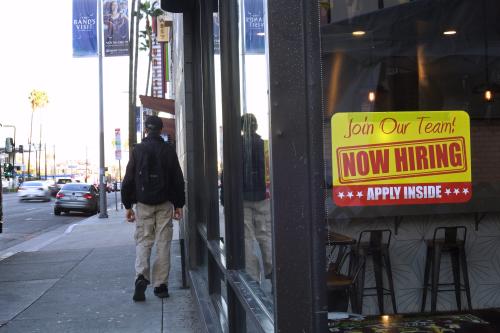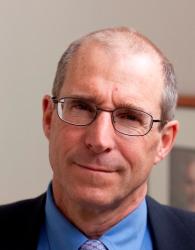Labor force participation plummeted by more than 3 percentage points during the first two months of the COVID-19 pandemic in 2020, representing a decline of more than 8.2 million people. While about half of the drop was quickly regained, participation has stagnated at about 1 percentage point below its pre-pandemic level. On this episode of the Brookings Podcast on Economic Activity, Louise Sheiner, policy director at the Hutchins Center on Fiscal and Monetary Policy, interviews Lea Rendell of the University of Maryland, one of the coauthors of a new BPEA study that asks, simply, “Where are the missing workers?” Sheiner and Rendell discuss several possible explanations, including fear of COVID-19 and shifting work-life balance preferences.
- Listen to the Brookings Podcast on Economic Activity on Apple, Spotify, Google, or wherever you like to get podcasts.
- Learn about other Brookings podcasts from the Brookings Podcast Network.
- Sign up for the podcasts newsletter for occasional updates on featured episodes and new shows.
- Send feedback email to [email protected].
TRANSCRIPT
[music]
STOCK: I’m Jim Stock, coeditor of the Brookings Papers on Economic Activity, the semiannual academic conference and journal that pairs rigorous research with real time policy analysis to address the most urgent economic challenges of the day. On behalf of my co-editor Jan Eberly of Northwestern University, as well as the rest of the Brookings team, I’d like to thank you for joining us for this episode of the Brookings Podcast on Economic Activity. Here we share conversations with leading economists on the research they do and how it will affect economic policy.
On this episode, you’ll hear from Lea Rendell of the University of Maryland on her new paper, “Where Are the Missing Workers?,” which she co-authored with Katharine Abraham, also of the University of Maryland. Lea will be interviewed by Louise Sheiner of the Hutchins Center on Fiscal and Monetary Policy.
Early in the pandemic, the U.S. labor market underwent enormous changes. Many workers started working from home, employment temporarily plunged, and many workers stopped looking for work. This final part, a decline in the fraction of workers in the labor force remains naggingly below pre-pandemic levels. The question of why so many workers, nearly 1% of adults, have exited the labor force is a big question, with important implications for future economic growth, inflation, and labor market policies.
Hand-in-hand, there has been a significant decline in hours worked, both in aggregate and per worker. Abraham and Rendell dig into various explanations for these twin puzzles, including direct COVID effects, long COVID, and economic incentives for early retirement. I think many observers will find the results surprising, and rather than giving them away, I invite you to enjoy this podcast, and now I’ll hand it over to Louise and Lea.
SHEINER: Thank you, Jim. I’m Louise Sheiner, Robert S. Kerr Senior Fellow in Economic Studies and policy director for the Hutchins Center on Fiscal and Monetary Policy. Joining me today is Lea Rendell of the University of Maryland, who coauthored a new BPEA study with Katharine Abraham titled, “Where Are the Missing Workers?” Lea and Katharine presented their research at the Spring 2023 Brookings Papers on Economic Activity Conference in Washington, D.C. Thank you, Lea, for joining the podcast.
RENDELL: Thank you so much for having me.
SHEINER: Now, the key question of your paper is right in the title, “Where are the missing workers?” Can you tell us what exactly do you mean by missing workers compared to what?
RENDELL: The puzzle that motivated our paper is the fact that both the share of the population in the labor force and the hours they are working have been notably lower compared to before the pandemic. Other labor force market data suggest that the labor market was just about as tight in December 2022 as it had been in December 2019. But if we look at the labor force participation rate, it is a full percentage point lower in December 2022.
The fact that it’s lower isn’t surprising. We knew that the aging of the baby boomers would lead to a drop in the participation rate as they retired. And even though the population is also getting more educated, which would counteract some of this decline, since participation increases with education, still in combination, the overall anticipated change in participation explains about half of the observed decline that we see.
But accounting for these demographic changes still leaves us with fewer people working than we would have expected. And the change in demographics don’t explain why hours have been lower since the pandemic. It’s these unanticipated changes that we have in mind when we talk about missing workers. And we would like to explain why these people are out of the labor force or why they are working fewer hours.
SHEINER: So, after accounting for changes in education and changes in the age structure of the population, you find that there are still about 1.5 million fewer workers in the labor force than would have been predicted prior to the pandemic. Can you tell us what you found and what explains why these people are missing?
RENDELL: Yeah. We think that there are two things that are going on. First, some people are not working because of long COVID. And the second reason is that some people are choosing not to work because they’re afraid of getting COVID.
First, let’s discuss the effect of long COVID on participation. The symptoms of long COVID, which include cognitive and mental health declines, have been debilitating for certain people. The question is how big of an impact that has had on participation. There have been some large estimates cited that we don’t think are plausible, but the best evidence we know of suggests it’s been an important factor.
One way to examine this was suggested in a 2022 paper by Goda and Soltas, who used information on the increase during the pandemic and the number of people who were absent from work due to an illness. This sharp jump in health-related absences tracked COVID case counts. So, it is a reasonable assumption that these individuals were out of work due to a COVID infection. And a fraction of these individuals who are out of work due to an infection will have developed long COVID. So, we can track how experiencing an absence from work affected their later participation.
Another approach suggested in your work with Nasiha Salwati, Louise, is to tease out the effects of long COVID from information on growth in the number of disabled people and their participation rates during the pandemic period.
What’s interesting is that these two approaches yield broadly similar results. When we extended both works through December 2022, we estimate that long COVID accounts for around 700,000 workers missing from the labor force.
And then the second thing is where we looked at how fear of COVID affected labor force participation. To estimate how fear of COVID has affected participation, it turns out that it really matters how you ask people about this. When you ask people if fear of COVID was a factor and them choosing not to work, more people will say that this is the case than if you ask them Why are you not working? And then you give them a list of options that include fear of COVID among the other possible reasons. With the latter question, some will still choose fear of COVID as the reason, but it’s going to be a smaller percentage. Estimates will also depend on how much you think fear of COVID contributes to their decision not to work when it’s listed as the secondary reason for not working.
Our best guess for how much fear of COVID affects participation is based on the Census Bureau’s household poll survey. It shows that in December 2022, about 0.4% of the population said that they were not working because of fear of COVID. Then we scale that estimate down a bit. First, we do this because we think that there are probably people who give this answer because it is a more socially acceptable reason for nonparticipation. And second, because we also think that there are some individuals who have fear of COVID, but have also had long COVID, and we want to make sure that we’re not counting them twice.
So, this is a pretty rough guess, but we estimate that around 790,000 workers are out of the labor force because of fear of COVID. Both long COVID and fear of COVID are important contributors to the missing workers. And when we combine the effects of long COVID and fear of COVID, we can fully explain the shortfall in the number of people in the labor force.
SHEINER: I think some people find maybe fewer missing workers than you do, because I think they get counted differently for trends that existed before the pandemic, for example, the declining participation rate of prime age males. How do you think about that? Or how did you account for it in your work?
RENDELL: Yeah, that’s right. I think that if you include trends, you’re going to see some things that were different. So, for example, we were seeing that for some groups in the population there were some earlier trends. And if you assume that those declines would have continued and you build that into your baseline expectations, fear of COVID and the effects on long COVID more than explain the unanticipated change. And that might sound a little bit odd, but it makes sense if the labor market was actually a little tighter in December 2022 than back in December 2019. So, there’s a bit of an increase to the labor force participation attributable to these cyclical factors.
SHEINER: So, in my work, looking at the effects of long COVID on labor force participation, which you built on and already discussed, we recognized that the advent of remote work might actually have positive effects on participation of people with disabilities. So, that is potentially another reason that it could be masking some of the declines from the negative effects of long COVID. And I think this is probably broadly true for participation of as a whole, not just for people with disabilities. So, it seems likely to me that the ability to work remotely even part time would bring people into the labor force, for example, mothers who want to be home for their kids when they get home from school. So, how did you think about this?
RENDELL: That’s a very good point. We unfortunately did not have the data that let us really tease this out separately, how the remote work may have interacted with other changes during the pandemic. This definitely does seem like something that will be really important to keep an eye on going forward.
As you’ve just mentioned, in your own work you see that the ability to work remotely made it easier for some of those with disabilities to return to the labor force. And you’re also mentioning parents, which I think is also going to be a really important contributor. I think that could definitely potentially benefit them from having the flexibility of remote work as well.
I think that this is really something where we need to make sure as we go forward that we are collecting the data to track how this is evolving.
SHEINER: So, you discussed two explanations for the drop in workforce—you discussed fear of COVID, and you discussed long COVID. I think in the paper you also looked at things like improving financial well-being because of the checks distributed and the unemployment insurance during the pandemic and the increase in the house prices and also changing work-life balances. What did you find about those?
RENDELL: So, we found that though they may have had some effects, maybe potentially earlier on, that overall we just didn’t see them contributing to the current decline and the labor force participation.
SHEINER: And what about caretaker responsibilities? We just talked about how the ability for remote work might eventually bring mothers in. But we heard a lot during the pandemic about how with school shut down and childcare hard to find that mothers had left the labor force. What did you find about that or did you look at that even?
RENDELL: We did look at that. And there’s a lot of evidence, and I think this is why this comes up a lot in the media, there’s a lot of evidence that the pandemic is making life harder for parents, for sure. I think that these constraints are making it much more difficult. But in our work, we just didn’t see a reduction in labor force participation for parents in comparison to non-parents during the pandemic. And our finding is consistent with other work examining the effects of the pandemic on parents like the 2021 paper by Furman, Carney, and Powell, who also find that there does not appear to be a parent specific decline in labor force participation.
SHEINER: Yeah. That’s so interesting. So, now let’s move on from labor force participation to hours. I think a lot of people had known about the decline in labor force participation, but the decline in ours was much less well known, and you find very large declines. Can you tell me about how big those effects were and what you think what caused them?
RENDELL: Of course. So, we find that between December 2019 and December 2022, average hours fell by 0.6 hours per week. That may not sound like a lot, but when we combine this in aggregate, this is equivalent to a loss of approximately 2.5 million workers. But unlike labor force participation, which we can fully explain by accounting for demographic changes combined with the effects from long COVID and also fear of COVID, demographic changes explain very little of the decrease in hours, and long COVID only explains a small amount—the equivalent of about 300,000 missing workers.
So, in contrast to the share of people who are in the labor force, COVID factors explain very little of why hours are falling, and that backs us into thinking that what may be going on is that some people are reevaluating the balance they want to strike between work and other things. There’s a lot of anecdotal evidence of individuals choosing to work fewer hours in favor of additional time with family, with friends, or doing hobbies. There’s also statistical evidence supporting that this reduction in hours is due to a shift in preferences.
There’s a recent paper by Faberman, Mueller, and Şahin, who show a similar pattern in reduction of hours worked as we do. But they also combine this with a survey that asks how many hours of work people want to be working. And what they found is that during the pandemic, people are choosing to reduce their hours, and they’re doing so because they want to be working less.
SHEINER: That’s really interesting. So, you can explain the decline in labor force participation, but there is an even bigger decline coming from hours, which is really coming more from preferences than anything else that we can explain. So, now let me step back and ask, like, the really two kind of big picture questions. So, the first one was why is it important to know whether or not there are missing workers or not? Like, how does the answer to that question affect the evaluation of, like, the state of the labor market or what we might predict will happen to hours and participation over the next few years?
RENDELL: Absolutely. That’s a really important question. And from a policy perspective, it’s important to understand how much slack there is in the labor market. So, for example, knowing that a large fraction of the shortfall in labor force is due to fear of COVID could support the idea that as we move further from the pandemic, as these people’s fears will subside, we will see these individuals reenter the labor market.
On the other hand, for the fraction of individuals who are out of the labor force because of long COVID, it’s much harder to predict what will happen in the next few years. This is because there’s still a lot of uncertainty about the reversibility of long COVID symptoms. If this is a permanent condition, we should not expect many of those individuals to return. And then when we’re talking about the shortfall due to the reduction in hours, if it’s a reevaluation of the workers’ preferences, then this decrease in hours could actually be a long-term change.
SHEINER: And to the extent that there are missing workers, which you find, is this something that we should just view as like the new normal, even for now, or maybe, as you say, some of it might reverse on its own? Or are there any policy prescriptions that go along with it?
RENDELL: So, yeah, I think that there are implications for policy, although maybe not in the way that we conventionally think about labor market policy. So, our paper finds that things outside of what we might typically think of as labor market drivers are in fact reshaping the labor market. But how to respond to fear of getting COVID, how to respond to the effects of long COVID, is really going to be addressed through health policy. And it frankly gets beyond my expertise to identify the right policy levers for addressing COVID or more broadly any infectious diseases in the future.
And with respect to people choosing to reduce their hours of work, it’s not clear that that is actually a subject for policy at all. If people are reducing their hours because they are reevaluating how they want to spend their time and reducing their hours increases their happiness, then working less is a good thing.
[music]
SHEINER: Well, thank you very much for joining me today for this discussion. If you’d like to read Lea’s full paper, visit Brookings dot edu slash BPEA and click the Spring 2023 button. Thanks very much.
STOCK: Once again, I’m Jim Stock, Harold Hitchings Burbank Professor of Political Economy at Harvard and coeditor of Brookings Papers on Economic Activity, and this has been the Brookings Podcast on Economic Activity. Thanks to our colleagues for this great conversation and be sure to subscribe to hear more discussions with BPEA authors.
The Brookings Podcast on Economic Activity is produced by the Brookings Podcast Network. Learn more about this and our other podcasts at Brookings dot edu slash podcasts. Send feedback to Podcasts at Brookings dot edu, and find out more about the Brookings Papers on Economic Activity on the website, Brookings dot edu slash BPEA.
Thanks to the team that makes this podcast possible, including Kuwilileni Hauwanga, supervising producer; Fred Dews, producer; and Gastón Reboredo, audio engineer; with support from Shannon Meraw and Chris Miller in Economic Studies at Brookings. Show art was designed by Katie Merris at Brookings, and promotional support comes from our colleagues in Brookings Communications and Economic Studies.









Commentary
Why haven’t workers returned to the labor force after COVID-19?
May 25, 2023